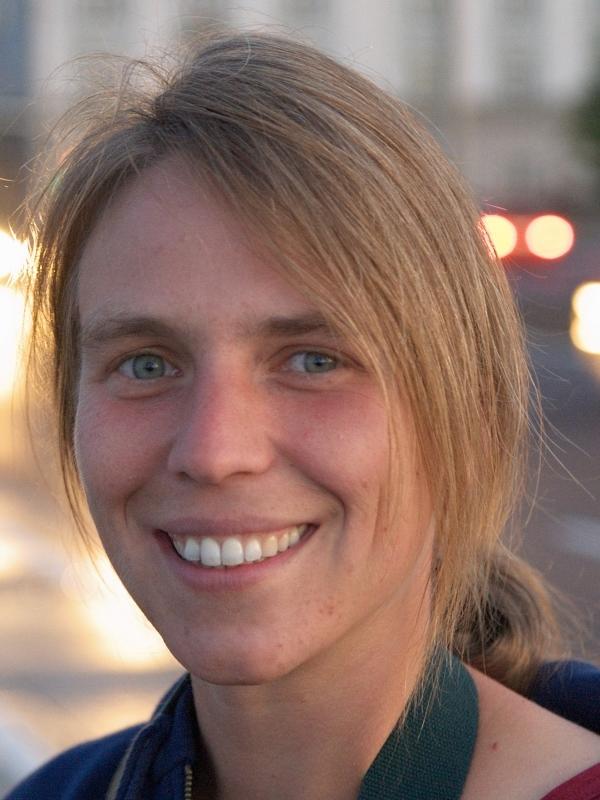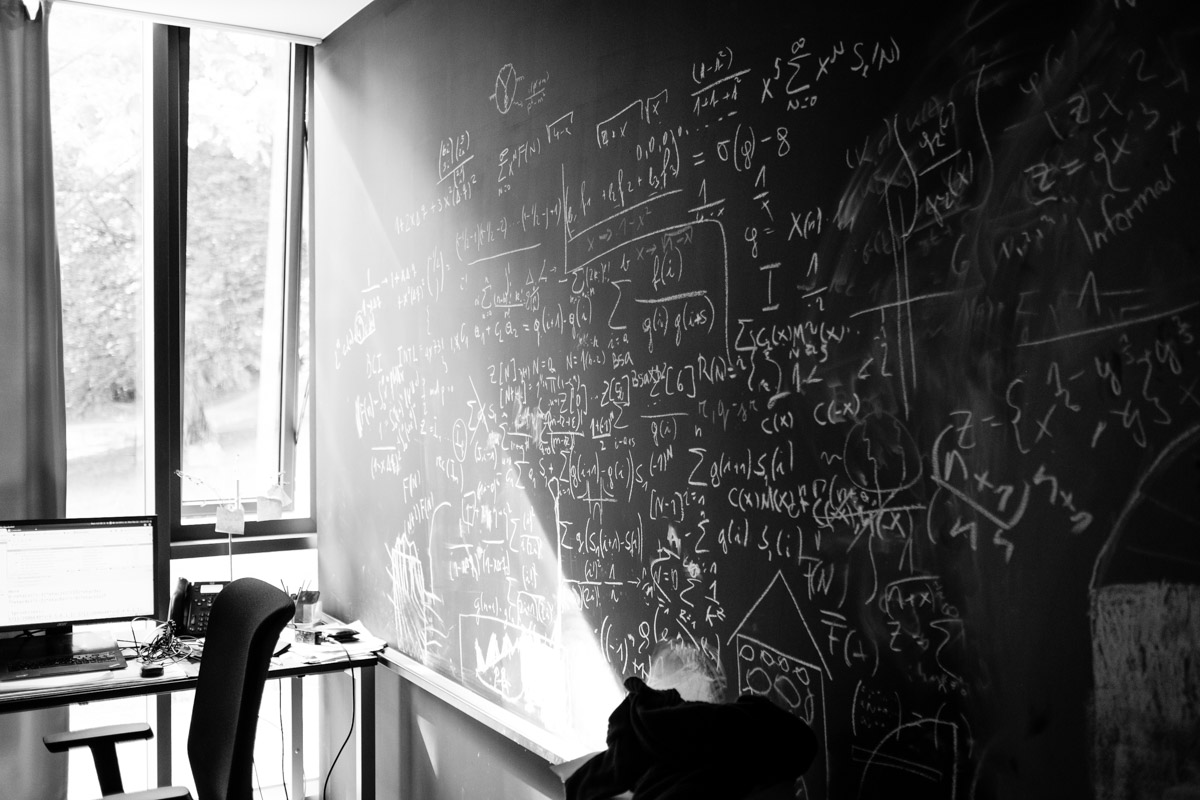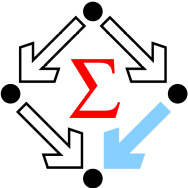Members

Koustav Banerjee

Abilio de Freitas

Nikolai Fadeev

Ralf Hemmecke

Philipp Nuspl

Peter Paule: Director 2009-2023

Veronika Pillwein

Cristian-Silviu Radu

Carsten Schneider: Director

Nicolas Smoot
Lukas Woegerer

Ongoing Projects
Computer Algebra for Multi-Loop Feynman Integrals
Software
Asymptotics
A Mathematica Package for Computing Asymptotic Series Expansions of Univariate Holonomic Sequences
This package is part of the RISCErgoSum bundle. The Asymptotics package provides a command for computing asymptotic series expansions of solutions of P-finite recurrence equations. ...
Bibasic Telescope
A Mathematica Implementation of a Generalization of Gosper's Algorithm to Bibasic Hypergeometric Summation
This package is part of the RISCErgoSum bundle. pqTelescope is a Mathematica implementation of a generalization of Gosper’s algorithm to indefinite bibasic hypergeometric summation. The package has been developed by Axel Riese, a former member of the RISC Combinatorics group. ...
Dependencies
A Mathematica Package for Computing Algebraic Relations of C-finite Sequences and Multi-Sequences
This package is part of the RISCErgoSum bundle. For any tuple f_1, f_2,..., f_r of sequences, the set of multivariate polynomials p such that p(f1(n),f2(n),...,fr(n))=0 for all points n forms ...
DiffTools
A Mathematica Implementation of several Algorithms for Solving Linear Difference Equations with Polynomial Coefficients
DiffTools is a Mathematica implementation for solving linear difference equations with polynomial coefficients. It contains an algorithm for finding polynomial solutions (by Marko Petkovsek), the algorithm by Sergei Abramov for finding rational solutions, the algorithm of Mark van Hoeij for ...
Paul Kainberger Short description DrawFunDoms.m is a Mathematica package for drawing fundamental domains for congruence subgroups in the modular group SL2(ℤ). It was written by Paul Kainberger as part of his master’s thesis under supervision of Univ.-Prof. Dr. ...
This package is part of the RISCErgoSum bundle. Engel is a Mathematica implementation of the q -Engel Expansion algorithm which expands q-series into inverse polynomial series. Examples of q-Engel Expansions include the Rogers-Ramanujan identities together with their elegant generalization by ...
A Mathematica package based on Sigma that tries to evaluate automatically multi-sums to expressions in terms of indefinite nested sums defined over (q-)hypergeometric products. ...
fastZeil
The Paule/Schorn Implementation of Gosper’s and Zeilberger’s Algorithms
This package is part of the RISCErgoSum bundle. With Gosper’s algorithm you can find closed forms for indefinite hypergeometric sums. If you do not succeed, then you may use Zeilberger’s algorithm to come up with a recurrence relation for that ...
GeneratingFunctions
A Mathematica Package for Manipulations of Univariate Holonomic Functions and Sequences
This package is part of the RISCErgoSum bundle. GeneratingFunctions is a Mathematica package for manipulations of univariate holonomic functions and sequences. ...
GenOmega
A Mathematica Implementation of Guo-Niu Han's General Algorithm for MacMahon's Partition Analysis
This package is part of the RISCErgoSum bundle. GenOmega is a Mathematica implementation of Guo-Niu Han’s general Algorithm for MacMahon’s Partition Analysis carried out by Manuela Wiesinger, a master student of the RISC Combinatorics group. Partition Analysis is a computational ...
Guess
A Mathematica Package for Guessing Multivariate Recurrence Equations
This package is part of the RISCErgoSum bundle. The Guess package provides commands for guessing multivariate recurrence equations, as well as for efficiently guessing minimal order univariate recurrence, differential, or algebraic equations given the initial terms of a sequence or ...
HarmonicSums
A Mathematica Package for dealing with Harmonic Sums, Generalized Harmonic Sums and Cyclotomic Sums and their related Integral Representations
The HarmonicSums package by Jakob Ablinger allows to deal with nested sums such as harmonic sums, S-sums, cyclotomic sums and cyclotmic S-sums as well as iterated integrals such as harmonic polylogarithms, multiple polylogarithms and cyclotomic polylogarithms in an algorithmic fashion. ...
HolonomicFunctions
A Mathematica Package for dealing with Multivariate Holonomic Functions, including Closure Properties, Summation, and Integration
This package is part of the RISCErgoSum bundle. The HolonomicFunctions package allows to deal with multivariate holonomic functions and sequences in an algorithmic fashion. For this purpose the package can compute annihilating ideals and execute closure properties (addition, multiplication, substitutions) ...
math4ti2.m is an interface package, allowing the execution of zsolve of the package 4ti2 from within Mathematica notebooks. The package is written by Ralf Hemmecke and Silviu Radu. Licence This program is free software: you can redistribute it and/or ...
ModularGroup
A Mathematica Package providing Basic Algorithms and Visualization Routines related to the Modular Group, e.g. for Drawing the Tessellation of the Upper Half-Plane
ModularGroup.m is a Mathematica package which has been developed in the course of the diploma thesis Computer Algebra and Analysis: Complex Variables Visualized, carried out at the Research Institute for Symbolic Computation (RISC) of the Johannes Kepler University Linz ...
MultiIntegrate
The MultiIntegrate package allows to compute multi-dimensional integrals over hyperexponential integrands in terms of (generalized) harmonic sums.
The MultiIntegrate package allows to compute multi-dimensional integrals over hyperexponential integrands in terms of (generalized) harmonic sums. This package uses variations and extensions of the multivariate Alkmkvist-Zeilberger algorithm. Registration and Legal Notices The source code for this package is password ...
MultiSum
A Mathematica Package for Proving Hypergeometric Multi-Sum Identities
This package is part of the RISCErgoSum bundle. MultiSum is a Mathematica package for proving hypergeometric multi-sum identities. It uses an efficient generalization of Sister Celine’s technique to find a homogeneous polynomial recurrence relation for the sum. The package has ...
Omega is a Mathematica implementation of MacMahon’s Partition Analysis carried out by Axel Riese, a Postdoc of the RISC Combinatorics group. It has been developed together with George E. Andrews and Peter Paule within the frame of a project initiated ...
ore_algebra
A Sage Package for doing Computations with Ore Operators
The ore_algebra package provides an implementation of Ore algebras for Sage. The main features for the most common instances include basic arithmetic and actions; gcrd and lclm; D-finite closure properties; natural transformations between related algebras; guessing; desingularization; solvers for polynomials, ...
OreSys
A Mathematica Implementation of several Algorithms for Uncoupling Systems of Linear Ore Operator Equations
This package is part of the RISCErgoSum bundle. OreSys is a Mathematica package for uncoupling systems of linear Ore operator equations. It offers four algorithms for reducing systems of differential or (q-)difference equations to higher order equations in a single ...
PermGroup
A Mathematica Package for Permutation Groups, Group Actions and Polya Theory
PermGroup is a Mathematica package dealing with permutation groups, group actions and Polya theory. The package has been developed by Thomas Bayer, a former student of the RISC Combinatorics group. ...
PLDESolver
The PLDESolver package is a Mathematica package to find solutions of parameterized linear difference equations in difference rings.
The PLDESolver package by Jakob Ablinger and Carsten Schneider is a Mathematica package that allows to compute solutions of non-degenerated linear difference operators in difference rings with zero-divisors by reducing it to finding solutions in difference rings that are integral ...
PositiveSequence
A Mathematica package for showing positivity of univariate C-finite and holonomic sequences
This package is part of the RISCErgoSum bundle. See Download and Installation. Short Description The PositiveSequence package provides methods to show positivity of C-finite and holonomic sequences. Accompanying files Demo.nb Hints Type ?PositiveSequence for information. The package is developed ...
The QEta package is a collection of programs written in the FriCAS computer algebra system that allow to compute with Dedekind eta-functions and related q-series where q=exp(2 π i τ). Furthermore, we provide a number of functions connected to the ...
qFunctions
The qFunctions package is a Mathematica package for q-series and partition theory applications.
The qFunctions package by Jakob Ablinger and Ali K. Uncu is a Mathematica package for q-series and partition theory applications. This package includes both experimental and symbolic tools. The experimental set of elements includes guessers for q-shift equations and recurrences ...
qGeneratingFunctions
A Mathematica Package for Manipulations of Univariate q-Holonomic Functions and Sequences
This package is part of the RISCErgoSum bundle. The qGeneratingFunctions package provides commands for manipulating q-holonomic sequences and power series. ...
qMultiSum
A Mathematica Package for Proving q-Hypergeometric Multi-Sum Identities
This package is part of the RISCErgoSum bundle. qMultiSum is a Mathematica package for proving q-hypergeometric multiple summation identities. The package has been developed by Axel Riese, a former member of the RISC Combinatorics group. ...
qZeil
A Mathematica Implementation of q-Analogues of Gosper's and Zeilberger's Algorithm
This package is part of the RISCErgoSum bundle. qZeil is a Mathematica implementation of q-analogues of Gosper’s and Zeilberger’s algorithm for proving and finding indefinite and definite q-hypergeometric summation identities. The package has been developed by Axel Riese, a former ...
RaduRK is a Mathematica implementation of an algorithm developed by Cristian-Silviu Radu. The algorithm takes as input an arithmetic sequence a(n) generated from a large class of q-Pochhammer quotients, together with a given arithmetic progression mn+j, and the level of ...
RatDiff
A Mathematica Implementation of Mark van Hoeij's Algorithm for Finding Rational Solutions of Linear Difference Equations
RatDiff is a Mathematica implementation of Mark van Hoeij's algorithm for finding rational solutions of linear difference equations. The package has been developed by Axel Riese, a Postdoc of the RISC Combinatorics group during a stay at the University of ...
RLangGFun
A Maple Implementation of the Inverse Schützenberger Methodology
The inverse Schützenberger methodology transforms a rational generating function into a (pseudo-) regular expression for a corresponding regular language, and is based on Soittola's Theorem about the N-rationality of a formal power series. It is implemented in the Maple package ...
Sigma
A Mathematica Package for Discovering and Proving Multi-Sum Identities
Sigma is a Mathematica package that can handle multi-sums in terms of indefinite nested sums and products. The summation principles of Sigma are: telescoping, creative telescoping and recurrence solving. The underlying machinery of Sigma is based on difference field theory. ...
Singular.m is an interface package, allowing the execution of Singular functions from Mathematica notebooks, written by Manuel Kauers and Viktor Levandovskyy. ...
Stirling
A Mathematica Package for Computing Recurrence Equations of Sums Involving Stirling Numbers or Eulerian Numbers
This package is part of the RISCErgoSum bundle. The Stirling package provides a command for computing recurrence equations of sums involving Stirling numbers or Eulerian numbers. ...
SumCracker
A Mathematica Implementation of several Algorithms for Identities and Inequalities of Special Sequences, including Summation Problems
This package is part of the RISCErgoSum bundle. The SumCracker package contains routines for manipulating a large class of sequences (admissible sequences). It can prove identities and inequalities for these sequences, simplify expressions, evaluate symbolic sums, and solve certain difference ...
Zeilberger
A Maxima Implementation of Gosper's and Zeilberger's Algorithm
Zeilberger is an implementatian for the free and open source Maxima computer algebra system of Gosper's and Zeilberger's algorithm for proving and finding indefinite and definite hypergeometric summation identities. The package has been developed by Fabrizio Caruso, a former Ph. ...
Publications
2025
Computer-assisted construction of Ramanujan-Sato series for 1 over pi
Ralf Hemmecke, Peter Paule, Cristian-Silviu Radu
Technical report no. 25-01 in RISC Report Series, Research Institute for Symbolic Computation (RISC), Johannes Kepler University Linz, Austria. ISSN 2791-4267 (online). January 2025. Licensed under CC BY 4.0 International. [doi] [pdf]author = {Ralf Hemmecke and Peter Paule and Cristian-Silviu Radu},
title = {{Computer-assisted construction of Ramanujan-Sato series for 1 over pi}},
language = {english},
abstract = {Referring to ideasof Takeshi Sato, Yifan Yang in~cite{YangDE} described a construction ofseries for $1$ over $pi$ startingwith a pair $(g,h)$, where $g$ is a modular formof weight $2$ and $h$ is a modular function; i.e.,a modular form of weight zero. In this article we present an algorithmicversion,called ``Sato construction''. Series for $1/pi$ obtained this way will becalled ``Ramanujan-Sato''series. Famous series fit into this definition, for instance, Ramanujan'sseries used by Gosperand the series used by the Chudnovsky brothersfor computing millions of digits of $pi$. Weshow that these series are induced by membersof infinite families of Sato triples $(N, gamma_N,tau_N)$ where $N>1$ is an integer and $gamma_N$ a $2times 2$ matrixsatisfying $gamma_N tau_N=N tau_N$ for$tau_N$ being an element from the upper half of thecomplex plane.In addition to procedures for guessingand proving from the holonomic toolbox togetherwiththe algorithm ``ModFormDE'', as describedin~cite{PPSR:ModFormDE1}, a central roleis played by the algorithm ``MultiSamba'',an extension ofSamba (``subalgebra module basis algorithm'') originating fromcite{Radu_RamanujanKolberg_2015} and cite{Hemmecke}.With thehelp of MultiSamba one canfind and prove evaluations of modular functions,at imaginary quadratic points, in terms of nested algebraic expressions.As a consequence,all the series for $1/pi$ constructed withthe help of MultiSamba are proven completelyin a rigorous non-numerical manner.},
number = {25-01},
year = {2025},
month = {January},
keywords = {modular forms and functions, holonomic differential equations, Ramanujan-Sato series for 1 over pi, MultiSamba algorithm},
length = {58},
license = {CC BY 4.0 International},
type = {RISC Report Series},
institution = {Research Institute for Symbolic Computation (RISC), Johannes Kepler University Linz},
address = {Altenberger Straße 69, 4040 Linz, Austria},
issn = {2791-4267 (online)}
}
Creative Telescoping for Hypergeometric Double Sums
P. Paule, C. Schneider
J. Symb. Comput. 128(102394), pp. 1-30. 2025. ISSN: 0747-7171. Symbolic Computation and Combinatorics: A special issue in memory and honor of Marko Petkovšek, edited by Shaoshi Chen, Sergei Abramov, Manuel Kauers, Eugene Zima. [doi]author = {P. Paule and C. Schneider},
title = {{Creative Telescoping for Hypergeometric Double Sums}},
language = {english},
abstract = {We present efficient methods for calculating linear recurrences of hypergeometric double sums and, more generally, of multiple sums. In particular, we supplement this approach with the algorithmic theory of contiguous relations, which guarantees the applicability of our method for many input sums. In addition, we elaborate new techniques to optimize the underlying key task of our method to compute rational solutions of parameterized linear recurrences.},
journal = {J. Symb. Comput.},
volume = {128},
number = {102394},
pages = {1--30},
isbn_issn = {ISSN: 0747-7171},
year = {2025},
note = {Symbolic Computation and Combinatorics: A special issue in memory and honor of Marko Petkovšek, edited by Shaoshi Chen, Sergei Abramov, Manuel Kauers, Eugene Zima},
refereed = {yes},
keywords = {creative telescoping; symbolic summation, hypergeometric multi-sums, contiguous relations, parameterized recurrences, rational solutions},
length = {30},
url = {https://doi.org/10.1016/j.jsc.2024.102394}
}
2024
The first-order factorizable contributions to the three-loop massive operator matrix elements $A_{Qg}^{(3)}$ and $Delta A_{Qg}^{(3)}$
J. Ablinger, A. Behring, J. Bluemlein, A. De Freitas, A. von Manteuffel, C. Schneider, K. Schoenwald
Nuclear Physics B 999(116427), pp. 1-42. 2024. ISSN 0550-3213. arXiv:2311.00644 [hep-ph]. [doi]author = {J. Ablinger and A. Behring and J. Bluemlein and A. De Freitas and A. von Manteuffel and C. Schneider and K. Schoenwald},
title = {{The first--order factorizable contributions to the three--loop massive operator matrix elements $A_{Qg}^{(3)}$ and $Delta A_{Qg}^{(3)}$}},
language = {english},
abstract = {The unpolarized and polarized massive operator matrix elements $A_{Qg}^{(3)}$ and $Delta A_{Qg}^{(3)}$contain first--order factorizable and non--first--order factorizable contributions in the determining difference or differential equations of their master integrals. We compute their first--order factorizable contributions in the single heavy mass case for all contributing Feynman diagrams. Moreover, we present the complete color--$zeta$ factors for the cases in which also non--first--order factorizable contributions emerge in the master integrals, but cancel in the final result as found by using the method of arbitrary high Mellin moments. Individual contributions depend also on generalized harmonic sums and on nested finite binomial and inverse binomial sums in Mellin $N$--space, and correspondingly, on Kummer--Poincar'e and square--root valued alphabets in Bjorken--$x$ space. We present a complete discussion of the possibilities of solving the present problem in $N$--space analytically and we also discuss the limitations in the present case to analytically continue the given $N$--space expressions to $N in mathbb{C}$ by strict methods. The representation through generating functions allows a well synchronized representation of the first--order factorizable results over a 17--letter alphabet. We finally obtain representations in terms of iterated integrals over the corresponding alphabet in $x$--space, also containing up to weight {sf w = 5} special constants, which can be rationalized to Kummer--Poincar'e iterated integrals at special arguments. The analytic $x$--space representation requires separate analyses for the intervals $x in [0,1/4], [1/4,1/2], [1/2,1]$ and $x > 1$. We also derive the small and large $x$ limits of the first--order factorizable contributions. Furthermore, we perform comparisons to a number of known Mellin moments, calculated by a different method for the corresponding subset of Feynman diagrams, and an independent high--precision numerical solution of the problems.},
journal = {Nuclear Physics B},
volume = {999},
number = {116427},
pages = {1--42},
isbn_issn = {ISSN 0550-3213},
year = {2024},
note = {arXiv:2311.00644 [hep-ph]},
refereed = {yes},
keywords = {Feynman diagram, massive operator matrix elements, computer algebra, differential equations, difference equations, coupled systems, nested integrals, nested sums},
length = {42},
url = {https://doi.org/10.1016/j.nuclphysb.2023.116427}
}
The non-first-order-factorizable contributions to the three-loop single-mass operator matrix elements $A_{Qg}^{(3)}$ and $Delta A_{Qg}^{(3)}$
J. Ablinger, A. Behring, J. Bluemlein, A. De Freitas, A. von Manteuffel, C. Schneider, K. Schoenwald
Physics Letter B 854(138713), pp. 1-8. 2024. ISSN 0370-2693. arXiv:2403.00513 [[hep-ph]. [doi]author = {J. Ablinger and A. Behring and J. Bluemlein and A. De Freitas and A. von Manteuffel and C. Schneider and K. Schoenwald},
title = {{The non-first-order-factorizable contributions to the three-loop single-mass operator matrix elements $A_{Qg}^{(3)}$ and $Delta A_{Qg}^{(3)}$}},
language = {english},
abstract = {The non-first-order-factorizable contributions to the unpolarized and polarized massive operator matrix elements to three-loop order, $A_{Qg}^{(3)}$ and $Delta A_{Qg}^{(3)}$, are calculated in the single-mass case. For the $_2F_1$-related master integrals of the problem, we use a semi-analytic method basedon series expansions and utilize the first-order differential equations for the master integrals whichdoes not need a special basis of the master integrals. Due to the singularity structure of this basis a part of the integrals has to be computed to $O(ep^5)$ in the dimensional parameter. The solutions have to be matched at a series of thresholds and pseudo-thresholds in the region of the Bjorken variable $x in ]0,infty[$ using highly precise series expansions to obtain the imaginary part of the physical amplitude for $x in ]0,1]$ at a high relative accuracy. We compare the present results both with previous analytic results, the results for fixed Mellin moments, and a prediction in the small-$x$ region. We also derive expansions in the region of small and large values of $x$. With this paper, all three-loop single-mass unpolarized and polarized operator matrix elements are calculated.},
journal = {Physics Letter B},
volume = {854},
number = {138713},
pages = {1--8},
isbn_issn = {ISSN 0370-2693},
year = {2024},
note = {arXiv:2403.00513 [[hep-ph]},
refereed = {yes},
keywords = {Feynman diagram, massive operator matrix elements, computer algebra, differential equations, difference equations, coupled systems, numerics},
length = {8},
url = {https://doi.org/10.1016/j.physletb.2024.138713}
}
Challenges for analytic calculations of the massive three-loop form factors
J Bluemlein, A. De Freitas, P. Marquard, C. Schneider
In: Proceedings of Loops and Legs in Quantum Field Theory, P. Marquard, M. Steinhauser (ed.)PoS(LL2024)03124-05, pp. 1-18. 2024. ISSN 1824-8039. arXiv:2408.07046 [hep-ph]. [doi]author = {J Bluemlein and A. De Freitas and P. Marquard and C. Schneider},
title = {{Challenges for analytic calculations of the massive three-loop form factors}},
booktitle = {{Proceedings of Loops and Legs in Quantum Field Theory}},
language = {english},
abstract = {The calculation of massive three-loop QCD form factors using in particular the large moments method has been successfully applied to quarkonic contributions in [1]. We give a brief review of the different steps of the calculation and report on improvements of our methods that enabled us to push forward the calculations of the gluonic contributions to the form factors.},
volume = {PoS(LL2024)031},
number = {24-05},
pages = {1--18},
isbn_issn = {ISSN 1824-8039},
year = {2024},
note = { arXiv:2408.07046 [hep-ph]},
editor = {P. Marquard and M. Steinhauser},
refereed = {no},
keywords = {Form factor; computer algebra, coupled systems, differential equations, recurrences, analytic continuation, holonomic functions},
length = {18},
url = {https://doi.org/10.22323/1.467.0031 }
}
The three-loop single-mass heavy flavor corrections to deep-inelastic scattering
J. Ablinger, A. Behring, J. Bluemlein, A. De Freitas, A. von Manteuffel, C. Schneider, K. Schoenwald
In: Proceedings of Loops and Legs in Quantum Field Theory, P. Marquard, M. Steinhauser (ed.)PoS(LL2024)047 , pp. 1-12. 2024. SSN 1824-8039. arXiv:2407.02006 [hep-ph]. [doi]author = {J. Ablinger and A. Behring and J. Bluemlein and A. De Freitas and A. von Manteuffel and C. Schneider and K. Schoenwald},
title = {{The three-loop single-mass heavy flavor corrections to deep-inelastic scattering}},
booktitle = {{Proceedings of Loops and Legs in Quantum Field Theory}},
language = {english},
abstract = {We report on the status of the calculation of the massive Wilson coefficients and operator matrix elements for deep-inelastic scatterung to three-loop order. We discuss both the unpolarized and the polarized case, for which all the single-mass and nearly all two-mass contributions have been calculated. Numerical results on the structure function $F_2(x,Q^2)$ are presented. In the polarized case, we work in the Larinscheme and refer to parton distribution functions in this scheme. Furthermore, results on the three-loop variable flavor number scheme are presented.},
volume = {PoS(LL2024)047 },
pages = {1--12},
isbn_issn = {SSN 1824-8039},
year = {2024},
note = {arXiv:2407.02006 [hep-ph]},
editor = {P. Marquard and M. Steinhauser},
refereed = {no},
keywords = {Feynman integrals, deep-inelastic scattering, numerical results},
length = {12},
url = {https://doi.org/10.22323/1.467.0047 }
}
Maximum-order Complexity and 2-Adic Complexity
Z. Chen, Z. Chen, J. Obrovsky, A. Winterhof
IEEE Transactions on Information Theory 70(8), pp. 6060-6067. 2024. ISSN: 0018-9448. [doi]author = {Z. Chen and Z. Chen and J. Obrovsky and A. Winterhof},
title = {{Maximum-order Complexity and 2-Adic Complexity}},
language = {english},
abstract = {The 2-adic complexity has been well-analyzed in the periodic case. However, we are not aware of any theoretical results in the aperiodic case. In particular, the Nth 2-adic complexity has not been studied for any promising candidate of a pseudorandom sequence of finite length N. Also nothing seems be known for a part of the period of length N of any cryptographically interesting periodic sequence. Here we introduce the first method for this aperiodic case. More precisely, we study the relation between Nth maximum-order complexity and Nth 2-adic complexity of binary sequences and prove a lower bound on the Nth 2-adic complexity in terms of the Nth maximum-order complexity. Then any known lower bound on the Nth maximum-order complexity implies a lower bound on the Nth 2-adic complexity of the same order of magnitude. In the periodic case, one can prove a slightly better result. The latter bound is sharp, which is illustrated by the maximum-order complexity of ell -sequences. The idea of the proof helps us to characterize the maximum-order complexity of periodic sequences in terms of the unique rational number defined by the sequence. We also show that a periodic sequence of maximal maximum-order complexity must be also of maximal 2-adic complexity.},
journal = {IEEE Transactions on Information Theory},
volume = {70},
number = {8},
pages = { 6060--6067},
isbn_issn = {ISSN: 0018-9448},
year = {2024},
refereed = {yes},
keywords = {Complexity theory;Polynomials;Random sequences;Cryptography;Surveys;Shift registers;Mathematics;Pseudorandom sequences;maximum-order complexity;2-adic complexity;ℓ-sequences},
length = {8},
url = {https://doi.org/10.1109/TIT.2024.3405946}
}
MacMahon's partition analysis XIV: Partitions with n copies of n
George E. Andrews, Peter Paule
Journal of Combinatorial Theory 203, pp. 0-0. 2024. Elsevier, 0097-3165. [doi]author = {George E. Andrews and Peter Paule},
title = {{MacMahon's partition analysis XIV: Partitions with n copies of n}},
language = {english},
journal = {Journal of Combinatorial Theory},
volume = {203},
pages = {0--0},
publisher = {Elsevier},
isbn_issn = {0097-3165},
year = {2024},
refereed = {yes},
length = {0},
url = {https://doi.org/10.1016/j.jcta.2023.105836}
}
Askey, Heron, and Computer Algebra
Peter Paule
RISC. Technical report no. 24-09, 12 2024. [pdf]author = {Peter Paule},
title = {{Askey, Heron, and Computer Algebra}},
language = {english},
number = {24-09},
year = {2024},
month = {12},
institution = {RISC},
length = {7}
}
MacMahon's partition analysis XV: Parity
George E. Andrews, Peter Paule
Journal of Symbolic Computation 127, pp. 0-0. 2024. RISC, 0747-7171. [doi]author = {George E. Andrews and Peter Paule},
title = {{MacMahon's partition analysis XV: Parity}},
language = {english},
abstract = {Paper ist 2024 erschienen, von den Editoren allerdings 2025 zugeordnet},
journal = {Journal of Symbolic Computation},
volume = {127},
pages = {0--0},
isbn_issn = {0747-7171},
year = {2024},
refereed = {yes},
institution = {RISC},
length = {0},
url = {https://doi.org/10.1016/j.jsc.2024.102351}
}
A tree-based algorithm for the integration of monomials in the Chow ring of the moduli space of stable marked curves of genus zero
Jiayue Qi
Journal of Symbolic Computation 122(102253), pp. -. 2024. ISSN: 0747-7171. [doi]author = {Jiayue Qi},
title = {{A tree-based algorithm for the integration of monomials in the Chow ring of the moduli space of stable marked curves of genus zero}},
language = {english},
journal = {Journal of Symbolic Computation},
volume = {122},
number = {102253},
pages = {--},
isbn_issn = {ISSN: 0747-7171},
year = {2024},
refereed = {yes},
length = {52},
url = {https://doi.org/10.1016/j.jsc.2023.102253}
}
Representation of hypergeometric products of higher nesting depths in difference rings
E.D. Ocansey, C. Schneider
J. Symb. Comput. 120, pp. 1-50. 2024. ISSN: 0747-7171. arXiv:2011.08775 [cs.SC]. [doi]author = {E.D. Ocansey and C. Schneider},
title = {{Representation of hypergeometric products of higher nesting depths in difference rings}},
language = {english},
journal = {J. Symb. Comput.},
volume = {120},
pages = {1--50},
isbn_issn = {ISSN: 0747-7171},
year = {2024},
note = {arXiv:2011.08775 [cs.SC]},
refereed = {yes},
length = {50},
url = {https://doi.org/10.1016/j.jsc.2023.03.002}
}
Error bounds for the asymptotic expansion of the partition function
Koustav Banerjee, Peter Paule, Cristian-Silviu Radu, Carsten Schneider
Rocky Mt J Math 54(6), pp. 1551-1592. 2024. ISSN: 357596. arXiv:2209.07887 [math.NT]. [doi] [pdf]author = {Koustav Banerjee and Peter Paule and Cristian-Silviu Radu and Carsten Schneider},
title = {{Error bounds for the asymptotic expansion of the partition function}},
language = {english},
abstract = {Asymptotic study on the partition function $p(n)$ began with the work of Hardy and Ramanujan. Later Rademacher obtained a convergent series for $p(n)$ and an error bound was given by Lehmer. Despite having this, a full asymptotic expansion for $p(n)$ with an explicit error bound is not known. Recently O'Sullivan studied the asymptotic expansion of $p^{k}(n)$-partitions into $k$th powers, initiated by Wright, and consequently obtained an asymptotic expansion for $p(n)$ along with a concise description of the coefficients involved in the expansion but without any estimation of the error term. Here we consider a detailed and comprehensive analysis on an estimation of the error term obtained by truncating the asymptotic expansion for $p(n)$ at any positive integer $n$. This gives rise to an infinite family of inequalities for $p(n)$ which finally answers to a question proposed by Chen. Our error term estimation predominantly relies on applications of algorithmic methods from symbolic summation. },
journal = {Rocky Mt J Math },
volume = {54},
number = {6},
pages = {1551--1592},
isbn_issn = {ISSN: 357596},
year = {2024},
note = {arXiv:2209.07887 [math.NT]},
refereed = {yes},
keywords = {partition function, asymptotic expansion, error bounds, symbolic summation},
length = {43},
url = {https://www.doi.org/10.1216/rmj.2024.54.1551}
}
Asymptotics for the reciprocal and shifted quotient of the partition function
Koustav Banerjee, Peter Paule, Cristian-Silviu Radu, Carsten Schneider
Technical report no. 24-06 in RISC Report Series, Research Institute for Symbolic Computation (RISC), Johannes Kepler University Linz, Austria. ISSN 2791-4267 (online). December 2024. Licensed under CC BY 4.0 International. [doi] [pdf]author = {Koustav Banerjee and Peter Paule and Cristian-Silviu Radu and Carsten Schneider},
title = {{Asymptotics for the reciprocal and shifted quotient of the partition function}},
language = {english},
abstract = { Let $p(n)$ denote the partition function. In this paper our main goal is to derive an asymptotic expansion up to order $N$ (for any fixed positive integer $N$) along with estimates for error bounds for the shifted quotient of the partition function, namely $p(n+k)/p(n)$ with $kin mathbb{N}$, which generalizes a result of Gomez, Males, and Rolen. In order to do so, we derive asymptotic expansions with error bounds for the shifted version $p(n+k)$ and the multiplicative inverse $1/p(n)$, which is of independent interest.},
number = {24-06},
year = {2024},
month = {December},
keywords = {{integer partitions, Hardy-Ramanujan Rademacher formula, asymptotic expansion, shifted quotient of partitions, symbolic summation},
length = {43},
license = {CC BY 4.0 International},
type = {RISC Report Series},
institution = {Research Institute for Symbolic Computation (RISC), Johannes Kepler University Linz},
address = {Altenberger Straße 69, 4040 Linz, Austria},
issn = {2791-4267 (online)}
}
Highway Node Routing
Christian Huber
Technical report no. 24-08 in RISC Report Series, Research Institute for Symbolic Computation (RISC), Johannes Kepler University Linz, Austria. ISSN 2791-4267 (online). July 2024. Bachelor thesis at RISC, Johannes Kepler University Linz. Licensed under CC BY 4.0 International. [doi] [pdf]author = {Christian Huber},
title = {{Highway Node Routing}},
language = {english},
abstract = {A routing server stands and falls with the routing algorithm behind it. In today’s world,where waiting times are less and less tolerated, it is all the more important to keep theresponse time as short as possible. After all, if the query takes too long, users are more likelyto switch providers than wait for the result. The more queries the system has to process,the more serious the problem becomes. The Dijkstra algorithm quickly comes to mind as asolution. However, this reaches its limits with larger traffic graphs, as we will see later. Amore sophisticated solution is required here: the highway node routing method introducedby D. Schultes. We will look at this approach step by step and check whether it satisfies therequirements of our problem.The idea behind this method is to add a hierarchy to the traffic graph. Each layer is asubset of the lower layers, maintaining the property of the optimal route. During the query,we move step by step to a higher layer, whereby fewer and fewer nodes and edges have to betaken into account, thereby achieving a significant acceleration. This idea emerges from thetraffic network. Assume that all roads are in the lowest layer. The first layer contains stateand federal roads and motorways. The second layer contains federal roads and motorwaysand the last layer contains only motorways. Routing in such a hierarchy no longer providesthe correct result, but it represents the basic idea of the algorithm. In this bachelor thesiswe will look at how we can calculate a correct hierarchy and elaborate the advantages anddisadvantages of this approach.},
number = {24-08},
year = {2024},
month = {July},
note = {Bachelor thesis at RISC, Johannes Kepler University Linz},
keywords = {routing algorithm, Dijkstra algorithm, hierarchy of traffic graphs, },
length = {44},
license = {CC BY 4.0 International},
type = {RISC Report Series},
institution = {Research Institute for Symbolic Computation (RISC), Johannes Kepler University Linz},
address = {Altenberger Straße 69, 4040 Linz, Austria},
issn = {2791-4267 (online)}
}
2023
Positivity of the second shifted difference of partitions and overpartitions: a combinatorial approach
Koustav Banerjee
Enumerative Combinatorics and Applications 3, pp. 1-4. 2023. ISSN 2710-2335. [doi]author = {Koustav Banerjee},
title = {{Positivity of the second shifted difference of partitions and overpartitions: a combinatorial approach}},
language = {english},
journal = {Enumerative Combinatorics and Applications},
volume = {3},
pages = {1--4},
isbn_issn = {ISSN 2710-2335},
year = {2023},
refereed = {yes},
length = {5},
url = {https://doi.org/10.54550/ECA2023V3S2R12}
}
Inequalities for the modified Bessel function of first kind of non-negative order
K. Banerjee
Journal of Mathematical Analysis and Applications 524, pp. 1-28. 2023. Elsevier, ISSN 1096-0813. [doi]author = {K. Banerjee},
title = {{Inequalities for the modified Bessel function of first kind of non-negative order}},
language = {english},
journal = {Journal of Mathematical Analysis and Applications},
volume = {524},
pages = {1--28},
publisher = {Elsevier},
isbn_issn = {ISSN 1096-0813},
year = {2023},
refereed = {yes},
length = {28},
url = {https://doi.org/10.1016/j.jmaa.2023.127082}
}
2-Elongated Plane Partitions and Powers of 7: The Localization Method Applied to a Genus 1 Congruence Family
K. Banerjee, N.A. Smoot
Technical report no. 23-10 in RISC Report Series, Research Institute for Symbolic Computation (RISC), Johannes Kepler University Linz, Austria. ISSN 2791-4267 (online). August 2023. Licensed under CC BY 4.0 International. [doi] [pdf]author = {K. Banerjee and N.A. Smoot},
title = {{2-Elongated Plane Partitions and Powers of 7: The Localization Method Applied to a Genus 1 Congruence Family}},
language = {english},
abstract = {Over the last century, a large variety of infinite congruence families have been discovered and studied, exhibiting a great variety with respect to their difficulty. Major complicating factors arise from the topology of the associated modular curve: classical techniques are sufficient when the associated curve has cusp count 2 and genus 0. Recent work has led to new techniques that have proven useful when the associated curve has cusp count greater than 2 and genus 0. We show here that these techniques may be adapted in the case of positive genus. In particular, we examine a congruence family over the 2-elongated plane partition diamond counting function $d_2(n)$ by powers of 7, for which the associated modular curve has cusp count 4 and genus 1. We compare our method with other techniques for proving genus 1 congruence families, and present a second congruence family by powers of 7 which we conjecture, and which may be amenable to similar techniques.},
number = {23-10},
year = {2023},
month = {August},
keywords = {Partition congruences, infinite congruence family, modular functions, plane partitions, partition analysis, modular curve, Riemann surface},
length = {35},
license = {CC BY 4.0 International},
type = {RISC Report Series},
institution = {Research Institute for Symbolic Computation (RISC), Johannes Kepler University Linz},
address = {Altenberger Straße 69, 4040 Linz, Austria},
issn = {2791-4267 (online)}
}
Analytic results on the massive three-loop form factors: quarkonic contributions
J. Bluemlein, A. De Freitas, P. Marquard, N. Rana, C. Schneider
Physical Review D 108(094003), pp. 1-73. 2023. ISSN 2470-0029. arXiv:2307.02983 [hep-ph]. [doi]author = {J. Bluemlein and A. De Freitas and P. Marquard and N. Rana and C. Schneider},
title = {{Analytic results on the massive three-loop form factors: quarkonic contributions}},
language = {english},
abstract = {The quarkonic contributions to the three--loop heavy-quark form factors for vector, axial-vector, scalar and pseudoscalar currents are described by closed form difference equations for the expansion coefficients in the limit of small virtualities $q^2/m^2$. A part of the contributions can be solved analytically and expressed in terms of harmonic and cyclotomic harmonic polylogarithms and square-root valued iterated integrals. Other contributions obey equations which are not first--order factorizable. For them still infinite series expansions around the singularities of the form factors can be obtained by matching the expansions at intermediate points and using differential equations which are obeyed directly by the form factors and are derived by guessing algorithms. One may determine all expansion coefficients for $q^2/m^2 rightarrow infty$ analytically in terms of multiple zeta values. By expanding around the threshold and pseudo--threshold, the corresponding constants are multiple zeta values supplemented by a finite amount of new constants, which can be computed at high precision. For a part of these coefficients, the infinite series in front of these constants may be even resummed into harmonic polylogarithms. In this way, one obtains a deeper analytic description of the massive form factors, beyond their pure numerical evaluation. The calculations of these analytic results are based on sophisticated computer algebra techniques. We also compare our results with numerical results in the literature.},
journal = {Physical Review D},
volume = {108},
number = {094003},
pages = {1--73},
isbn_issn = {ISSN 2470-0029},
year = {2023},
note = {arXiv:2307.02983 [hep-ph]},
refereed = {yes},
keywords = {form factor, Feynman diagram, computer algebra, holonomic properties, difference equations, differential equations, symbolic summation, numerical matching, analytic continuation, guessing, PSLQ},
length = {92},
url = {https://www.doi.org/10.1103/PhysRevD.108.094003}
}
Recent 3-Loop Heavy Flavor Corrections to Deep-Inelastic Scattering
J. Ablinger, A. Behring, J. Bluemlein, A. De Freitas, A. Goedicke, A. von Manteuffel, C. Schneider, K. Schoenwald
In: Proc. of the 16th International Symposium on Radiative Corrections: Applications of Quantum Field Theory to Phenomenology , Giulio Falcioni (ed.), PoS RADCOR2023046, pp. 1-7. June 2023. ISSN 1824-8039. arXiv:2306.16550 [hep-ph]. [doi]author = {J. Ablinger and A. Behring and J. Bluemlein and A. De Freitas and A. Goedicke and A. von Manteuffel and C. Schneider and K. Schoenwald},
title = {{Recent 3-Loop Heavy Flavor Corrections to Deep-Inelastic Scattering}},
booktitle = {{Proc. of the 16th International Symposium on Radiative Corrections: Applications of Quantum Field Theory to Phenomenology }},
language = {english},
abstract = {We report on recent progress in calculating the three loop QCD corrections of the heavy flavor contributions in deep--inelastic scattering and the massive operator matrix elements of the variable flavor number scheme. Notably we deal with the operator matrix elements $A_{gg,Q}^{(3)}$ and $A_{Qg}^{(3)}$ and technical steps to their calculation. In particular, a new method to obtain the inverse Mellin transform without computing the corresponding $N$--space expressions is discussed.},
series = {PoS},
volume = {RADCOR2023},
number = {046},
pages = {1--7},
isbn_issn = {ISSN 1824-8039},
year = {2023},
month = {June},
note = {arXiv:2306.16550 [hep-ph]},
editor = {Giulio Falcioni},
refereed = {no},
keywords = {deep-inelastic scattering, 3-loop Feynman diagrams, (inverse) Mellin transform, binomial sums},
length = {7},
url = { https://doi.org/10.22323/1.432.0046 }
}




